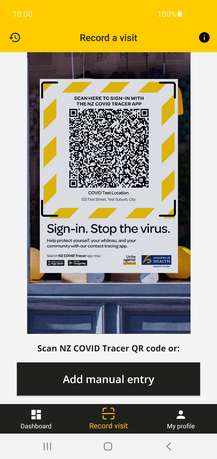
A barcode or bar code is a method of representing data in a visual, machine-readable form. Initially, barcodes represented data by varying the widths, spacings and sizes of parallel lines. These barcodes, now commonly referred to as linear or one-dimensional (1D), can be scanned by special optical scanners, called barcode readers, of which there are several types. Later, two-dimensional (2D) variants were developed, using rectangles, dots, hexagons and other patterns, called matrix codes or 2D barcodes, although they do not use bars as such. 2D barcodes can be read using purpose-built 2D optical scanners, which exist in a few different forms. 2D barcodes can also be read by a digital camera connected to a microcomputer running software that takes a photographic image of the barcode and analyzes the image to deconstruct and decode the 2D barcode. A mobile device with a built-in camera, such as smartphone, can function as the latter type of 2D barcode reader using specialized application software.

A mobile payment, also referred to as mobile money, mobile money transfer and mobile wallet, is any of various payment processing services operated under financial regulations and performed from or via a mobile device, as the cardinal class of digital wallet. Instead of paying with cash, cheque, or credit cards, a consumer can use a payment app on a mobile device to pay for a wide range of services and digital or hard goods. Although the concept of using non-coin-based currency systems has a long history, it is only in the 21st century that the technology to support such systems has become widely available.

A barcode reader or barcode scanner is an optical scanner that can read printed barcodes, decode the data contained in the barcode to a computer. Like a flatbed scanner, it consists of a light source, a lens and a light sensor for translating optical impulses into electrical signals. Additionally, nearly all barcode readers contain decoder circuitry that can analyse the barcode's image data provided by the sensor and send the barcode's content to the scanner's output port.

Semacode is a software company based in Waterloo, Ontario, Canada. It is also this company's trade name for their machine-readable ISO/IEC 16022 Data Matrix barcodes, which are used to encode Internet URLs.

A QR code is a type of two-dimensional matrix barcode, invented in 1994, by Japanese company Denso Wave for labelling automobile parts. A barcode is a machine-readable optical image that contains information specific to the labelled item. In practice, QR codes contain data for a locator, an identifier, and web tracking. To efficiently store data, QR codes use four standardized modes of encoding (i) numeric, (ii) alphanumeric, (iii) byte or binary, and (iv) kanji.

Windows Live Barcode was a part of Microsoft's Windows Live services. It allowed users to transfer information between various media and handsets via Quick Response Code, a two-dimensional matrix barcode. It provided a method for people to exchange information and use various online services on handsets.
A guard tour patrol system is a system for logging the rounds of employees in a variety of situations such as security guards patrolling property, technicians monitoring climate-controlled environments, and correctional officers checking prisoner living areas. It helps ensure that the employee makes their appointed rounds at the correct intervals and can offer a record for legal or insurance reasons. Such systems have existed for many years using mechanical watchclock-based systems. Computerized systems were first introduced in Europe in the early 1980s, and in North America in 1986. Modern systems are based on handheld data loggers and RFID sensors. The system provides a means to record the time when the employee reaches certain points on their tour. Checkpoints or watchstations are commonly placed at the extreme ends of the tour route and at critical points such as vaults, specimen refrigerators, vital equipment, and access points. Some systems are set so that the interval between stations is timed so if the employee fails to reach each point within a set time, other staff are dispatched to ensure the employee's well-being. An example of a modern set-up might work as follows: the employee carries a portable electronic sensor (PES) or electronic data collector which is activated at each checkpoint. Checkpoints can consist of iButton semiconductors, magnetic strips, proximity microchips such as RFIDs or NFC- or optical barcodes. The data collector stores the serial number of the checkpoint with the date and time. Later, the information is downloaded from the collector into a computer where the checkpoint's serial number will have an assigned location. Data collectors can also be programmed to ignore duplicate checkpoint activations that occur sequentially or within a certain time period. Computer software used to compile the data from the collector can print out summaries that pinpoint missed checkpoints or patrols without the operator having to review all the data collected. Because devices can be subject to misuse, some have built-in microwave, g-force, and voltage detection.

High Capacity Color Barcode (HCCB) is a technology developed by Microsoft for encoding data in a 2D "barcode" using clusters of colored triangles instead of the square pixels conventionally associated with 2D barcodes or QR codes. Data density is increased by using a palette of 4 or 8 colors for the triangles, although HCCB also permits the use of black and white when necessary. It has been licensed by the ISAN International Agency for use in its International Standard Audiovisual Number standard, and serves as the basis for the Microsoft Tag mobile tagging application.
Mobile tagging is the process of providing data read from tags for display on mobile devices, commonly encoded in a two-dimensional barcode, using the camera of a camera phone as the reader device. The contents of the tag code is usually a URL for information addressed and accessible through Internet.
Brand protection is the process and set of actions that a right holder undertakes to prevent third parties from using its intellectual property without permission, as this may cause loss of revenue and, usually more importantly, destroys brand equity, reputation and trust. Brand protection seeks primarily to ensure that trademarks, patents, and copyrights are respected, though other intellectual property rights such as industrial design rights or trade dress can be involved. Counterfeiting is the umbrella term to designate infringements to intellectual property, with the exception of the term piracy which is sometimes (colloquially) used to refer to copyright infringement.
Asset tracking refers to the method of tracking physical assets, either by scanning barcode labels attached to the assets or by using tags using GPS, BLE, LoRa, or RFID which broadcast their location. These technologies can also be used for indoor tracking of persons wearing a tag.
Inventory management software is a software system for tracking inventory levels, orders, sales and deliveries. It can also be used in the manufacturing industry to create a work order, bill of materials and other production-related documents. Companies use inventory management software to avoid product overstock and outages. It is a tool for organizing inventory data that before was generally stored in hard-copy form or in spreadsheets.

The application Barcode Scanner is an Android app, from the open-source project ZXing, that allows an Android device with imaging hardware to scan barcodes or 2D barcodes and retrieve the data encoded. Information encoded often includes web addresses, geographical coordinates, and small pieces of text, in addition to commercial product codes. This Android-based system has similar functionality to a hardware barcode reader.

Screen-Smart Device Interaction (SSI) is fairly new technology developed as a sub-branch of Digital Signage.

Scan is a mobile app development company headquartered in Provo, Utah, United States. The company was founded in January 2011 by Garrett Gee together with his college friends Ben Turley and Kirk Ouimet. The company, owned and operated by Scan, Inc, was acquired by Snapchat in 2014.

NZ COVID Tracer is a mobile software application that enables a person to record places they have visited, in order to facilitate tracing who may have been in contact with a person infected with the COVID-19 virus. The app allows users to scan official QR codes at the premises of businesses and other organisations they visit, to create a digital diary. It was launched by New Zealand's Ministry of Health on 20 May 2020, during the ongoing COVID-19 pandemic. It can be downloaded from the App Store and Google Play.
Barcode library or Barcode SDK is a software library that can be used to add barcode features to desktop, web, mobile or embedded applications. Barcode library presents sets of subroutines or objects which allow to create barcode images and put them on surfaces or recognize machine-encoded text / data from scanned or captured by camera images with embedded barcodes. The library can support two modes: generation and recognition mode, some libraries support barcode reading and writing in the same way, but some libraries support only one mode.
LeaveHomeSafe is a digital contact tracing app launched by the Hong Kong Government on 16 November 2020 to conduct contact tracing in Hong Kong. It can be used as a companion of the Hong Kong Health Code system for registered users.
SafeEntry was a national check-in system which enables the logging of visitors at various locations during the COVID-19 pandemic in Singapore, allowing health authorities to track and isolate confirmed clusters. It was used in tandem with TraceTogether, the national contact tracing platform in Singapore. The system was deactivated on 9 February 2023 after authorities determined there was no longer a need for the system.
Scandit AG, commonly referred to as Scandit, is a Swiss technology company that provides smart data capture software. Their technology allows any smart device equipped with a camera to scan barcodes, IDs and text and to perform additional functions using augmented reality and advanced analytics.










